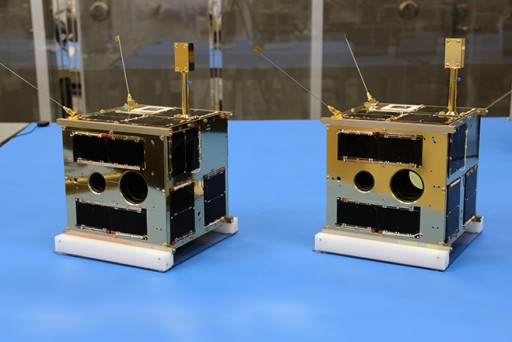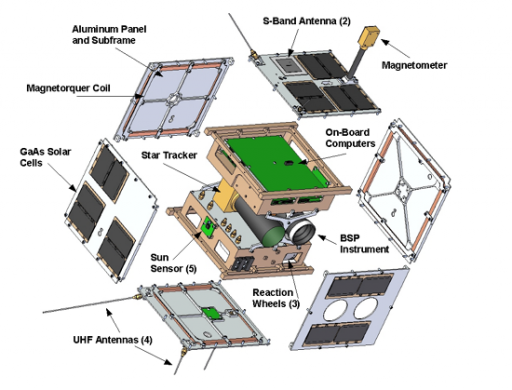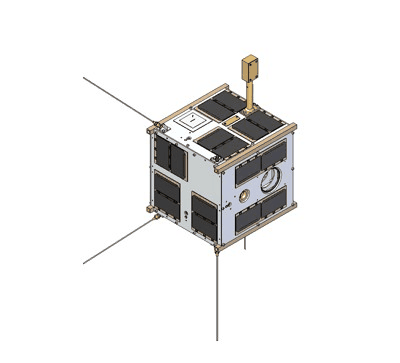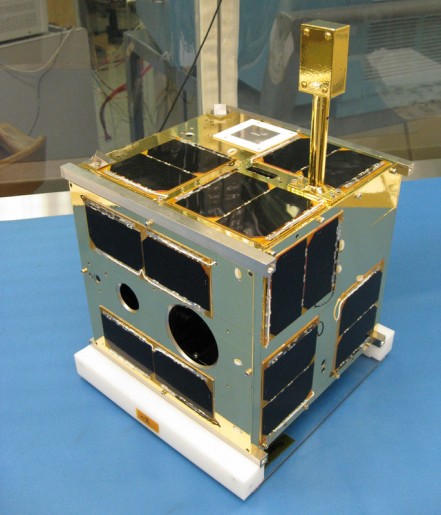BRITE-CA

The BRITE-CA 1 and 2 satellites are also known under their full name of BRIght-star Target Explorer or CanX-3 (Canadian Advanced Nanospace eXperiments). These two 7-Kilogram spacecraft host a wide-field telescope payload that will be used to conduct differential photometry measurements of bright stars.The BRITE-CA satellites were developed at the University of Toronto to follow the UniBRITE, BRITE-Austria and BRITE-PL satellites that were funded before the two Canadian contributions received funding.
The BRITE-CA satellites use the Generic Nanosatellite Bus designed around a 20 by 20 by 20 centimeter cube. Power is provided by four to ten triple-junction GaAs solar cells installed on each of the external panels delivering up to ten Watts of power. Power is stored in Li-Ion batteries with a capacity of 5.3 Ah and the power conditioning unit provides a 4-Volt unregulated power bus.

Attitude Determination is accomplished by a three-axis magnetometer, six sun sensors for fine and sun attitude determination and a star tracker for precise attitude determination. The Miniature Star Tracker provides three-axis attitude solutions at a control cycle at 0.5 Hz and an accuracy of 10arcsec. Attitude actuation is provided by three reaction wheels with a total mass of 185grams and a volume of 5 by 5 by 4 centimeters. The wheels have a momentum capacity of 30mNms and deliver a maximum torque of 2mNm. Momentum dumps are supported by three magnetotorquers.
Data handling and satellite control is provided by an ARM7 housekeeping computer that handles standard telemetry and communications while a second computer supports all attitude determination and control functions. A third computer board is in charge of the operation of the science payload and handles its data. Each processor board uses the ARM7/TDMI processor with a code memory of 256kB and 2MB of hardware SRAM memory used to store program variables and data. A 256MB flash memory is used for long-term data storage.
The communications system of the satellite uses an S-Band system operating at 2234.4 MHz for data downlink reaching data rates of 32 to 256kbit/s. Uplink is accomplished at 437MHz in UHF with a data rate of 4kbit/s. A 0.1W VHF 145MHz beacon can be used for spacecraft tracking. BRITE-CA will downlink up to 8MB of payload data per day.


The science payload of BRITE-CA includes a photometer consisting of an optical head, an electronics tray and the baffle. The baffle includes an aperture stop and filters while the optical head houses five lenses. BRITE-CA examines the brightest stars in the sky for variability using precise differential photometry over time scales of days and months to answer questions on the life cycles of bright stars.
Using its payload, BRITE is capable of studying all stars brighter than magnitude +3.5. To track the periodic, semi-periodic and irregular variations of bright stars that occur on time scales of minutes to months, BRITE will perform continuous precise photometric time-series measurements by making measurements of a target star field of at least 15 minutes per orbit over a period of several months.
Changes in star intensity occur due to changes in density, magnetic field, surface temperature and internal seismic phenomena.
To capture data on a wide field of view, the BRITE photometer has an FOV of 24 by 19°.
The photometer payload uses a five-lens design with an aperture of three centimeters and a CCD detector. The optical cell uses spacers to hold the lenses in their positions with a total focal length of seven centimeters. Overall, the photometer weighs 900 grams and requires 3W of power,

The detector is a KAI-11002 CCD – a 11 megapixel interline, buried channel CCD with 4008 by 2672 pixels that are 9 by 9 micrometers in size creating an image size of 37.25 by 25.70 mm. An electronic shutter is implemented in the system as well as anti-blooming protection. The effective wavelength range of the instrument is limited by the sensitivity of the detector in the red spectral range and in the blue by the transmission properties of the lenses. The optical filters were designed so that stars of 10,000K cause the same detector output. The blue filter installed on one BRITE-CA spacecraft covers a spectral range of 390 to 460nm while the red filter of the other satellite covers 550 to 700nm with a transmission rate of 95%.
The photometer is capable of performing differential photometry measurements with an error of less than 0.1% over a 15-minute observation using exposure times of 0.1 to 100 seconds. The CCD read-out is converted from analog to digital using a 14-bit scheme to convert the analog pixel values. A 32MB instrument memory can temporarily hold a full picture until it can be transmitted to the spacecraft.
